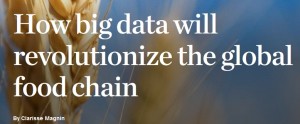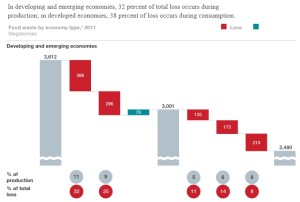Advanced analytics opens vast untapped potential for farmers, investors, and emerging economies to reduce the cost of goods sold. The way digital technologies are reshaping the relationship between consumers and brands has been hotly debated over the past few years, with much discussion of the reshaping of consumer decision journeys, the advent of multichannel marketing and sales, and the impact of smartphones and the mobile Internet on customer behavior. Yet an even bigger opportunity has been largely overlooked. By taking advantage of big data and advanced analytics at every link in the value chain from field to fork, food companies can harness digital’s enormous potential for sustainable value creation. Digital can help them use resources in a more environmentally responsible manner, improve their sourcing decisions, and implement circular-economy solutions in the food chain.
Huge untapped potential
So far, most of the excitement about digital’s potential in the consumer-packaged-goods industry has centered on marketing and sales. But for food producers, the opportunities begin higher upstream and end lower downstream. At the upstream end, the agricultural practices followed by dairy farmers, cacao and coffee producers, wheat and barley producers, cattle farmers, and so on result in enormous variations in commodity costs in an industry where raw materials represent easily 60 percent of the cost of goods sold (COGS).
Manufacturing and packaging also represent a substantial share of COGS, as well as contributing to companies’ environmental and social footprints and food-safety risks. At the other end of the food chain, big data and advanced analytics can be used to optimize downstream activities such as waste management. Food waste causes economic losses, harms natural resources, and exacerbates food-security issues. About a third of food produced for human consumption is lost or wasted every year in a world where 795 million people—a ninth of the population—go hungry.
Cutting postharvest losses in half would produce enough food to feed a billion more people. Global food waste and loss cost $940 billion a year, have a carbon footprint of 4.4 Gt CO2-equivalent (more than 8 percent of global greenhouse-gas emissions), and a blue-water footprint of about 250 cubic km (3.6 times the annual consumption of the US). In 2007, the amount of food wasted globally equated to 1.4 billion hectares—an area bigger than Canada—of agricultural production.
Using technology to improve areas such as climate forecasting, demand planning, and the management of end-of-life products could bring enormous social, economic, and environmental benefits. For example, the French start-up Phenix runs a web-based marketplace to connect supermarkets with end-of-life food stocks to NGOs and consumers who could use them. The platform enables the supermarkets to save the costs of disposal, gives consumable products a second life, and alleviates some of the social and environmental burden of waste.
Would you like to learn more about our Consumer Packaged Goods Practice? Visit our Big Data & Advanced Analytics page
….
By Clarisse Magnin,
Clarisse Magnin is a senior partner in McKinsey’s Paris office and an EMEA leader in the Retail, Private Equity and Operations Practices; she also leads the consumer hub in France and is a global leader in the Sustainability and Resource Productivity Practice.
More: www.mckinsey.com

